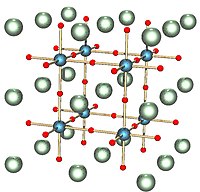
Photo from wikipedia
Most current thermoelectric materials have important drawbacks, such as toxicity, scarceness, and peak operating temperatures above 300 °C. Herein, we report the thermoelectric properties of different crystalline phases of Sn-based… Click to show full abstract
Most current thermoelectric materials have important drawbacks, such as toxicity, scarceness, and peak operating temperatures above 300 °C. Herein, we report the thermoelectric properties of different crystalline phases of Sn-based perovskite thin films. The 2D phase, Cs2SnI4, is obtained through vacuum thermal deposition and easily converted into the black β phase of CsSnI3 (B-β CsSnI3) by annealing at 150 °C. B-β CsSnI3 is a p-type semiconductor with a figure of merit (ZT) ranging from 0.021 to 0.033 for temperatures below 100 °C, which makes it a promising candidate to power small electronic devices such as wearable sensors which may be interconnected in the so-called Internet of Things. The B-β phase is stable in nitrogen, whereas it spontaneously oxidizes to Cs2SnI6 upon exposure to air. Cs2SnI6 shows a negative Seebeck coefficient and an ultralow thermal conductivity. However, the ZT values are 1 order of magnitude lower than for B-β CsSnI3 due to a considerably lower electrical conductivity.
Journal Title: ACS Applied Energy Materials
Year Published: 2022
Link to full text (if available)
Share on Social Media: Sign Up to like & get
recommendations!